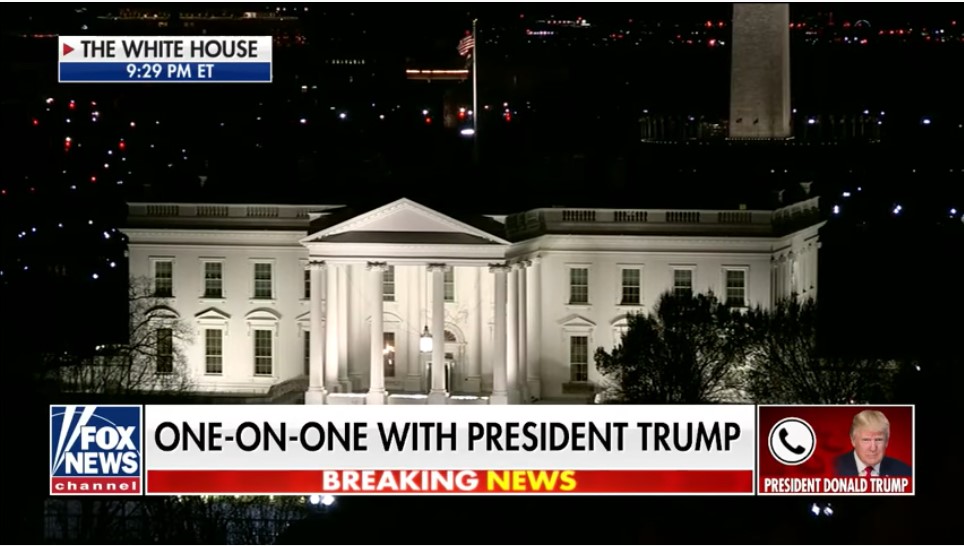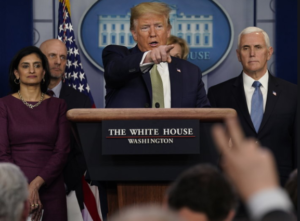With Coronavirus Pandemic, The President Can’t Have Rallies. But He’s Still In the Spotlight

A week ago on Sean Hannity’s Fox News show, President Trump was adamant he would not cancel the Republican National Convention in August.
“Somebody was asking today, ‘Will you cancel your convention?’ I said no way I’m going to cancel the convention,” Trump said. “We’re going to have the convention, it’s going to be incredible.”
And on Tuesday, former vice president Joe Biden, the likely Democratic nominee, was asked about the Democratic National Convention by Brian Williams.
“Can you really envision every prominent Democrat in this country from all 50 states inside a hot arena, 104 days from now?” Williams asked.
Biden said he couldn’t.
“It’s hard to envision that,” he said. “Again we should listen to the scientists. And one of the reasons why the Democratic convention was going to be held early was the Olympics. We have more time now.”
On this episode of Inside Politics: The RNC in Charlotte, we’re going to look at how the pandemic has upended the presidential campaign, wiping out – for now — any traditional campaign events by Biden, and MAGA rallies too.
And the episode will look at how this crisis has affected the president’s approval ratings – and those of past presidents in other crises. It will also give an update on the state Board of Election’s recommendations to make it easier for people to vote by mail.
While President Trump can no longer have Make America Great Again rallies with the coronavirus pandemic limiting large gatherings, he has found a different forum: The near-daily press briefings.
Those briefings are the subject of a Politico story “Trump Turns a Crisis Into His New Nightly TV Show.” It’s written by Michael Kruse, who covers what he calls “Trumpology.”

“There is an element of suspense in them in that we sort of wonder what he’s going to say,” Kruse said. “What kinds of tiffs he’s going to get into with various reporters. Who is going to be there of the members of what we’ve come to see is kind of the supporting cast of public health professionals. The doctors, the admiral, the cabinet members.”
The briefings have drawn a lot of viewers and listeners. In a tweet Sunday, Trump quoted a New York Times article about them.
He tweeted: “President Trump is a ratings hit. … His coronavirus updates have attracted an average audience of 8.5 million … roughly the viewership of the season finale of “The Bachelor.”
“President Trump is a ratings hit. Since reviving the daily White House briefing Mr. Trump and his coronavirus updates have attracted an average audience of 8.5 million on cable news, roughly the viewership of the season finale of ‘The Bachelor.’ Numbers are continuing to rise…
— Donald J. Trump (@realDonaldTrump) March 29, 2020
Kruse said the president has managed to make the daily briefings into a soap opera, with the public wondering who will get the credit and blame.
And there are questions. Will Dr. Anthony Fauci be on the show, or will he be written out of the script? What about Dr. Deborah Birx, the coronavirus response coordinator?
“What will Dr. Birx say?” Kruse said. “How will she navigate the odd dynamics of trying to push back at something President Trump might say without totally pushing back against what President Trump has just said?”

Last month, Trump called the anti-malarial drug chloroquine a “game-changer” in regard to treating COVID-19 — and said the FDA had already approved its use. Fauci was asked about that the next day.
“The information that you’re referring to specifically is anecdotal; it was not done in a clinical trial so you can’t make any definitive statement about it,” he said.
Trump then said: “Without saying too much I’m probably more of a fan of that than anything … but I’ve seen things that are impressive. We’re going to know soon. “
“These are kind of the latest installment in the ongoing ‘Trump Show’ that has been his presidency and to some extent, his existence, overall,” Kruse said.
Kruse said the exchange between Trump and NBC News reporter Peter Alexander was enlightening. Trump said Alexander was a terrible reporter who asked him a “very nasty question.”
“I think at that point, fairly early in the response to the worsening pandemic, there was still sort of the question for the American public, whether or not we would see a slightly different Donald Trump, given the gravity of the situation,” Kruse said. “And in that moment, I think it’s fair to say we all understood, perhaps we shouldn’t have thought this in the first place. But we all understood that Donald Trump still was Donald Trump.”
Kruse said the president has struggled with an enemy he can’t bully on Twitter.
“The coronavirus is a different kind of enemy and it is as tough a nut as he has had to try to crack,” he said. “He has tried though ” calling it the ‘invisible enemy,’ calling it the ‘hidden scourge,’ and of course calling it the ‘Chinese virus’ until all of a sudden one day he was not calling it the ‘Chinese virus.’ But to put a face on an enemy has been a particular challenge on this front. He tried with the ‘Chinese virus’ which is a very comfortable way for him to go to try to put an ethnicity, to put a color on it to put a national face on an enemy that, by definition, knows no borders, but he has tried to create similar dynamics to what he’s done in the past.”
And one of those dynamics is the attention to staging.
Kruse said Trump’s longtime adviser Roger Stone told him that the president “always understood that how you look is ultimately more important than what you say.”
“Once, I remember talking to Chuck Todd from NBC who said that after he interviewed Trump on the campaign trail in 2015 and ’16, he would ask to have the camera sort of flipped around so we could watch on the small screen to see how he looked,” Kruse said. “But to watch on mute — that’s how he wanted to sort of study the performance he had just given.”
Kruse added: “In those evening briefings when families are perhaps eating dinner, and CNN is on and the sound is down, the image that comes across is Donald Trump. The President in the center of that stage looking like he’s on top of things and in charge, regardless of whether or not he actually is, regardless of the particulars of the response, regardless of the particulars of, you know, the amount of medical equipment that is or is not getting to nurses and doctors all over the country. He looks like he’s in charge, and I think that is something you’re seeing in some of those approval bumps.”
The President’s Approval Ratings Went Up. Is That Significant?
David Hopkins is a Boston College political science professor who wrote the book Red Fighting Blue: How Geography and Electoral Rules Polarize American Politics. He said a rise in Trump’s approval rating is a “familiar pattern.”
“Which is called the ‘Rally Effect,’” Hopkins said. “Short for ‘rally around the flag.’ When there is a time of national crisis, the approval ratings for the president rise. And we’ve seen this happen ever since we’ve had good survey data to measure it. And so it’s not very surprising that Trump’s numbers are up a bit because probably any president in this situation would be up a bit.”
ABC News and the Washington Post found that 49% of registered voters approve of the president’s performance, compared with 47% who disapprove. That was for the period between March 22 to March 25.
Another highly rated poll from Monmouth University shows that 46% of voters either have a favorable or very favorable impression of the president.
“Going back to when he took office, and that’s the highest number that we registered for him,” said Patrick Murray, the director of the Monmouth poll. “So it’s clear that there is some benefit that people do want to be able to rally around the president, for example. He’s never been in double-digits among Democrats at all. Now, his approval rating among Democrats is 11%.”
Murray said it’s interesting that Trump’s approval ratings have increased by only a few points.
“We talk about his numbers moving in terms of two or three points as being extremely significant,” he said. “And we would have never done that for another president. We would expect to see bigger shifts in these times the times, but because of our partisan tribes here in America are so entrenched, we don’t really — we’ve never seen a lot of movement. And even when we get to a nationwide pandemic, which has basically shut down most of the country, we still don’t see a lot of movement. Which says a lot about, you know, where we are as a public right now as much as anything else.”
The uptick in approval ratings for the president has shown up in head-to-head matchups with Biden.
Murray doesn’t know if that’s because people are responding positively to the president, or if it’s because Biden has been invisible.
During a Zoom press conference this week – from what he called his recreation room — Biden brushed off that concern.
A reporter asked Biden if he was concerned about getting his message across.
“Well, I was, but I’m finding out that what you’ve mastered along before me that the new technologies are quite effective,” he said. “For example, I noticed that when I laid out my plan a couple of days, three days ago or four days ago that it didn’t get covered on the national (networks), but I found out 3.8 million people watched it online.”
Biden has also held tele-fundraisers.
One last month was hosted by the former chairman and CEO of the Coca-Cola company.
Notable guests were former Georgia Sen. Sam Nunn and Sally Yates, the former acting U.S. attorney general. And according to a pool report from the event – the Biden campaign allows reporters to cover parts of his fundraisers – one donor said she is “concerned about is that we see Donald Trump every day with this crisis giving his press report. And I would just love to see you more. Like how do we get more of you and less of him on our airwaves?”
Murray said Biden’s campaign pause reminds him of 1988.
“One of the things that we saw if we go back in time in 1988, that was one of the times that we saw public opinion shift very radically,” Murray said. “When Michael Dukakis had won the nomination, but then went off the campaign trail for the summer of 1988. He went from being a double-digit favorite to win that election to being behind because he wasn’t campaigning — and president George H.W. Bush was out there on the trail.”
Right after the DNC in July 1988, Dukakis had a 17-point lead over Bush – 55 to 38. But after the RNC in August in New Orleans, Bush was back on top.
“And that’s one of the things I think that the Biden campaign might be worried about right now, is the sense that they just don’t have a platform in which they can just simply remind people that they are there,” he said. “So that’s why he’s going to do interviews on places like ‘The View,’ things that have a large audience just to try to remind people that he’s still he’s still around.”
But Hopkins, the Boston College professor, said he thinks this campaign is different.
“It’s certainly true that Biden won’t be the focus of attention for a while,” he said. But that isn’t necessarily very damaging for him. It’s not really an election that will turn on what people think about him but what they think about Trump.”
How Big Is This Rally Effect Compared To Others?
If you go back to 1962, President Kennedy’s approval rating had been sliding through the summer and fall of that year. But after the Cuban Missile Crisis – which was in October, right before the midterms – more than 70% of the country approved of his performance.
And then in November 1979, when the U.S. Embassy in Iran was stormed and hostages were taken, President Carter’s approval rating went from 32% in a Gallup poll to 61%.
But the hostage crisis – and the economy – wiped out that rally effect. By the spring of 1980, Carter was back to between 30-40%.
President George H.W. Bush received a boost in August 1990 when Iraq invaded Kuwait, with his Gallup approval pushing past 70%. And then after Desert Storm in February, it briefly approached 90%.
And the biggest Rally Effect ever came after 9/11. George W. Bush’s approval rating at the end of September was 90%. For Gallup, that’s the highest approval rating ever.
Update From The Last Episode
On the last episode, we discussed how the executive director of the North Carolina Board of Elections, Karen Brinson Bell, had floated the idea of sending every registered voter a mail ballot. She is preparing for an increase in mail voting because of the pandemic.
Brinson Bell made recommendations to the governor and the General Assembly last week. She didn’t propose sending everyone a mail ballot.
But she proposed making it easier for people to vote by mail.
Today you need either a notary to sign your mail ballot or two witnesses. And to encourage social distancing, she wants to require only one witness or eliminate that requirement all together. And there are other proposals, like having prepaid postage to return mail ballot request forms and making it easier to request a ballot altogether.
She also proposed making Election Day, for 2020 at least, a state holiday. The reason is that she’s worried about having enough volunteers to work precincts because most of those volunteers are elderly – and most in danger to COVID-19
So if November 3 is a state holiday, there could be a large pool of people who could volunteer to work at the polls, like teachers and state workers.
But Senate leader Phil Berger is cool to the idea.
“I understand that some progressive, liberal Democratic groups would like to roll that back and put us back to where we were,” he said. “I’m afraid that’s where the elections director would take us with her proposals.”
Click here to subscribe to the Inside Politics podcast (and to give the podcast a rating/review in your favorite podcast app).
Want more? You can sign up here for our weekly Inside Politics newsletter, written by Steve Harrison.
Have a question about the 2020 RNC in Charlotte? Ask us below.